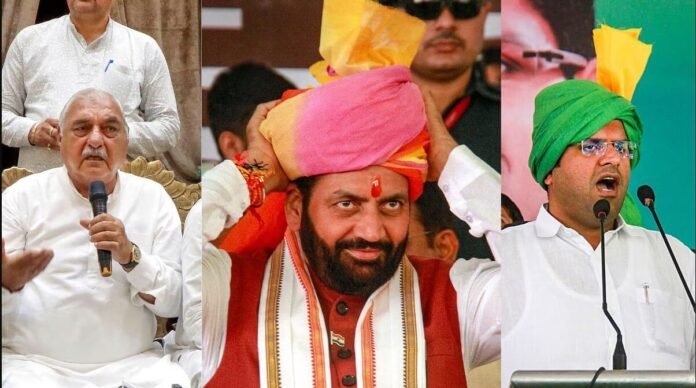As Haryana gears up for its 2024 assembly elections, the political landscape is witnessing significant shifts, with parties and leaders recalibrating their strategies to win over the state’s diverse electorate. The election, scheduled for later this year, promises to be a closely watched contest, especially given the state’s unique socio-political context. Haryana, with its mix of rural and urban populations, a strong agricultural sector, and growing industrial hubs, has always been a key political battleground in North India.
Election 2024: Key Players in the 2024 Battle
Bharatiya Janata Party (BJP)
The BJP has been in power in Haryana since 2014, with Manohar Lal Khattar serving as the Chief Minister for two consecutive terms. Under Khattar’s leadership, the BJP has promoted development projects focused on infrastructure, rural development, and health services. However, the party faces challenges, especially post the farmers’ protests, which severely impacted its image in the rural areas.

The BJP is expected to heavily rely on its core Hindutva agenda and its national leadership, particularly Prime Minister Narendra Modi and Home Minister Amit Shah, to pull through. The party is working hard to mend its relationship with the farmers and rural voters, launching several schemes aimed at the agrarian sector. In urban areas, the focus will be on the state’s industrial growth and employment generation to woo the younger population.
Congress
The Congress, which once dominated Haryana politics, has seen a resurgence under the leadership of Bhupinder Singh Hooda, the former Chief Minister of the state. Hooda has a stronghold in the Jat-dominated regions and has been instrumental in consolidating support against the BJP. His consistent push for farmers’ issues and criticism of the Khattar government’s handling of the agrarian crisis has resonated well with many voters.
However, internal rifts within the Congress might be a hurdle. There are divisions between the Hooda faction and other senior leaders like Kumari Selja, the state Congress president. The party’s challenge will be to present a united front to capitalize on the anti-incumbency sentiment against the BJP.

Indian National Lok Dal (INLD) and Jannayak Janata Party (JJP)
The INLD, once a formidable force in Haryana, led by Om Prakash Chautala, has lost much of its sheen. The split in the party, leading to the formation of the JJP under Dushyant Chautala, has further weakened its electoral prospects. However, both the INLD and JJP retain some influence, particularly in rural areas, and may play a crucial role in case of a hung assembly.

Dushyant Chautala’s JJP, which is currently in an alliance with the BJP, is expected to face a tough time defending its position. The party’s base of Jat voters, especially after the farmers’ protests, may have grown disillusioned with the current state leadership. Whether the JJP will continue its alliance with the BJP or seek new partnerships remains to be seen as election day approaches.
Emerging Issues and Voter Sentiment
Agrarian Distress and Farmers’ Protests
The aftermath of the 2020-21 farmers’ protests is one of the most critical factors in this election. The farmers, a significant voter base in Haryana, were at the forefront of the agitation against the now-repealed farm laws. Though the laws have been withdrawn, the scars of the protests remain, with many rural voters still holding grudges against the BJP government for its initial stance.
Agrarian distress, including rising input costs, water scarcity, and inadequate MSP (Minimum Support Price) for crops, continues to be a pressing issue. The Congress and other opposition parties are expected to focus on this, promising better support for the farmers and criticizing the ruling party for neglecting their concerns.
Employment and Youth Engagement
Haryana’s youth, particularly in urban and semi-urban areas, are increasingly concerned about unemployment and the lack of industrial growth in the state. While the BJP government has initiated several projects aimed at boosting job creation, opposition parties have criticized them as insufficient. With a young voter base, employment is expected to be a decisive issue. The state’s proximity to the national capital and the rising aspirations of its youth will make this a battleground for all major political parties.
Law and Order
Law and order have been a perennial issue in Haryana, with sporadic incidents of violence, particularly related to caste tensions. The BJP government has tried to project itself as strong on law and order, but incidents of communal unrest and clashes between different social groups have led to concerns over the state’s stability.
Opposition parties, especially the Congress, are expected to raise this issue, questioning the government’s ability to maintain peace and social harmony in a diverse state like Haryana.
The Road Ahead
As Haryana inches closer to its assembly elections, the political dynamics are fluid, with parties making last-minute alliances and strategies to gain the upper hand. The BJP, with its stronghold in urban centers, will need to do significant damage control in rural areas, while the Congress will need to bridge its internal divides and present a unified front.
The INLD and JJP, though diminished, could still be kingmakers in a closely contested election. The role of independents and smaller parties might also be critical in what is shaping up to be a highly competitive election.
With agrarian distress, unemployment, and social stability dominating voter concerns, this election will test the political mettle of Haryana’s key players and may redefine the future political landscape of the state. The upcoming months will see intense campaigning, strategic alliances, and political maneuvering as Haryana’s electorate prepares to make its choice for the next five years.

